Ants are common throughout the world in many different ecosystems. More than 450 species of ants live in North America. They are also one of the most common pests in human environments and dwellings. In human environments, they build nests in soil, open lawns, under concrete slabs, stones or boards, adjacent to foundation walls, in the walls of houses, in decaying wood, or in cavity spaces associated with debris. Some nests are relatively permanent while others last for a short period of time. Less than 50 species have been known to invade homes across the United States, and only about 10 of these commonly enter homes in Missouri.
Ants are social insects. Three main castes cooperate to carry out the various biological roles within an ant colony. These castes include queens, workers and males (Figure 1). Queen ants lay eggs while workers take care of the eggs and larvae, build and defend the nest and locate food to maintain the colony. Males appear for a brief period each year and function only in mating. The social behavior of ants has enabled them to become one of the most successful and abundant groups of insects. Homeowners and pest-management professions commonly consider ants to be the most common and difficult insects to manage.
 Figure 1
Figure 1
The little black ant: A, male; B, pupa; C, female; D, female with wings; E, worker; F, larva; G, eggs; H, group of workers in line of march. A to G much enlarged, H about 1-1/2 times actual size.
Biology and habits
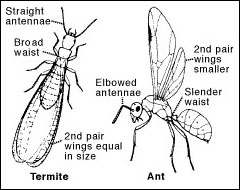 Figure 2
Figure 2
Distinguishing features of a winclass="photoartfl"ged ant versus a winged termite.
The immature stages in an ant colony include eggs, larvae and pupae. Most all of the eggs produced by ant queens are fertilized, hatch into female larvae and later develop into wingless workers. A small number of unfertilized eggs are also laid, which are viable and hatch into larvae that develop into winged males.
Ant larvae are legless, grub-like and helpless. They must be fed, cleaned and moved around by adult workers. These larvae perform a unique role within the colony. Unlike worker ants, larvae can consume solid food particles. Any solid food brought back to the colony by workers must be fed to larvae, who regurgitate it in liquid form. Workers and queens can then utilize this liquid food. The pupae are an inactive pre-adult stage.
Most individuals in an ant colony are wingless female workers. In some species, all the workers in the colony are the same size while other species have multiple sizes of workers. If a colony has multiple sizes of workers, they are called either majors or minors. Workers live only nine to 10 weeks in some species, while other species have workers that live more than six years. Most workers in the colony perform nest-building and maintenance duties while relatively few look for food.
Ants are omnivores and search for a variety of foods. The search for food is the primary reason ants enter buildings and become pests. The search for food typically involves individual ants meandering away from the nest. When an ant discovers food, she takes a straight route back to the nest and lays a scent trail as she returns. Other workers follow her scent trail to the discovered food and recruit large numbers of their nestmates to quickly exploit it. When the food source is liquid, workers consume it and store excess in their bodies to regurgitate and share with the rest of the colony. When the food is solid, the ants transport it back to the nest, where larvae convert it to liquid and then feed it back to workers. The most common natural food source for ants is honeydew. Honeydew is a liquid excretion made by insects such as aphids, mealybugs and scales. Often ants guard these insects as they feed on plant leaves, stems or roots in order to have unlimited access to the honeydew they produce.
Depending on the species, an ant colony has either a single queen or multiple queens. In some species, queens live for only six months, but in others, they can live for more than six years. Mature colonies also produce winged queens at a certain time each year that swarm from their colonies during favorable environmental conditions. Winged queens fly to nearby landmarks to form mating aggregations with winged males. These landmarks include trees, bushes or structures. These landmarks are often used year after year. Winged ant swarmers can be confused with termite swarmers, but they can easily be distinguished from winged termites by differences in the structure of their wings, antennae and body (Figure 2).
Winged males die soon after mating, but the queen sheds her wings and searches for favorable sites to establish a new colony. Preferred nest sites vary by species. Depending on the species, new queens and budding workers nest either in soil, wood or void spaces under or between objects. Each species has its own preferred nest material and will not nest in other situations. Some ant species do not swarm to start new colonies. In these species, groups of workers simply take larvae from their own nest and move to another location where they raise these larvae as new queens. This behavior is called budding.
Wood nests consist of galleries hollowed out inside logs, stumps or structural wood including door frames, window frames, rafters, flooring, wall studs, etc. Wood nests typically have some kind of sawdust and debris caused from the ants associated with them. Soil nests are excavations that produce some kind of mound in the grass or on the surface of the soil. Cavity nests are associated with void spaces under or between objects. These void spaces may include mulch beds, debris piles, leaf packs, landscaping stones and timbers, inside walls, electrical boxes, etc.
Most ants are not pests in human environments. A few are even considered beneficial as predators on other insect pests. A few ants are considered pests because they invade homes or build mounds in lawns, parks or golf courses. Others are pests because they negatively impact human health or cause economic damage to wooden structures. Some of the most common pest ants in Missouri are discussed later in this guide.
Ants impact human health by stinging or through contamination of food. Stinging ants in Missouri include acrobat ants (Crematogaster spp.) and the pavement ant (Tetramorium caespitum). The red imported fire ant (Solenopsis invicta) is a common stinging ant in human environments in the southeastern United States, but it is not currently established in Missouri. Contamination of food by ants occurs when they visit unsanitary areas in the home and carry germs on their bodies to clean areas where food is stored and/or prepared. Although any ant could potentially carry germs on its body, the odorous house ant (Tapinoma sessile) and pharaoh ant (Monomorium pharaonis) are the most likely carriers of contaminants in Missouri because of their abundance and behavior.
Ants that nest in wood can cause economic damage to human structures. Various species of acrobat ants (Crematogaster spp.) and carpenter ants (Camponotus spp.) nest in wooden parts of human structures in Missouri. These ants hollow out dead and decaying wood to build a nest or use existing voids in the building as a nest site. They do not eat the wood, but they excavate tunnels in the wood to lay eggs and raise larvae and pupae. In some situations, these excavations can be extensive.
Management
Eliminating an ant colony requires eliminating the queen and eliminating the workers. If you accomplish both of these objectives, you can consider your efforts successful. If you only eliminate workers, the queen will produce more and your infestation will return. If you only eliminate the queen, workers will continue to invade your home.
Ants invade homes through small openings from the outside. These openings include cracks and crevices in the foundation, small openings under siding, gaps under doors or around windows, ventilation openings, laundry vents, plumbing penetrations, electrical wiring outlets, etc. Once inside, ants follow structural edges or guidelines where walls meet floors, windows, contact walls, between baseboards and floors, between shelving and walls or along water pipes and electrical wiring.
When they discover a food source, worker ants form trails. Following this trail can provide clues about what the ants are feeding on, where the colony is located and how they are getting into the home.
Non-chemical control
Observe the ants closely to find what they are feeding on and where they are coming from. Try not to disrupt the trailing ants until you have answered these questions. Once you know where their nest site is and where they are feeding, you can understand how best to manage the infestation.
Most non-chemical strategies focus on minimizing the likelihood that ants can get into your home or on reducing the available resources they can find once inside. Some common recommendations include:
- Repair and caulk cracks and crevices where ants enter the home. Pay special attention to areas around doors, windows, siding, foundation, vents, pipes, etc.
- Eliminate outdoor nesting areas around the home such as piles of debris, rocks, boards, leaves, tall grass, etc.
- Place ant-attractive foods in glass or plastic jars that are sealed tightly or store them in the refrigerator.
- Clean all kitchen surfaces and sweep or vacuum the floor thoroughly each day to remove all food scraps.
- Rinse dinner dishes and wash dishes daily to reduce the availability of food.
- Rinse used glass, metal and plastic food containers before throwing them into the garbage can or recycling bin.
- Take out the garbage regularly and keep outdoor trash cans clean and in good repair.
You can remove trailing ants that are already inside by wiping the ant trail with a sponge saturated with soapy water. This is only temporary, though, and the ants will reestablish trails soon. Further work is necessary to reduce ant activity indoors.
Insecticides
You have two options for strategies to manage ants directly with insecticides. Depending on the species, you should choose either bait applications that the ants carry back to the nest or liquid applications that you apply directly to the nest to eliminate the colony. Nest applications are the most effective choice for soil- and wood-nesting species with a single queen when you can locate the nest or mound. Bait applications are the most effective when dealing with cavity-nesting species that have multiple queens and nest cavities.
When managing wood- and soil-nesting species, the key to control is locating their nest and applying a liquid insecticide. Most ants that invade homes nest outside in the soil or adjacent to the soil under various objects. Carpenter ants occupy both indoor and outdoor locations, but the queen is nearly always outside. By observing and following the feeding trails made by a colony, you can often discover the nest site. When the nest side is located, apply liquid insecticides into the nest to kill the queen, workers and larvae. For wood nests, drill multiple small holes into the galleries and inject liquid until the gallery system is completely saturated. For soil nests, pour liquid onto the nest and saturate it completely at the rate of one gallon of insecticide for each foot of diameter of the mound. In other words, apply one quart of insecticide for each 3 inches of mound width.
If you cannot locate the nest but ants are coming into the structure from outside, an outdoor perimeter spray can be effective. Spray the foundation from the ground up to about 3 feet and the ground from the foundation out to about 3 feet. Be sure to spray well around all doors and basements windows. Indoors, you can kill workers by spraying their trails around windowsills, door thresholds, cracks or crevices, baseboards, behind and under cabinets and appliances, and other surfaces. Do not contaminate food or utensils and do not spray food-preparation surfaces. The following active ingredients are commonly available to drench nests, to spray the perimeter, or to treat active trails:
- Pyrethroids (bifenthrin, cyfluthrin, cypermethrin, deltamethrin, lambdacyhalothrin, permethrin, prallethrin, tetramethrin)
- Carbaryl (Sevin)
- Chrysanthemate
- Benzeneacetate
- Bicycloheptene dicarboximide
Ants are exposed to the insecticide and killed as they crawl over treated areas. Because only workers are killed, re-treatment is usually always necessary. You must continue to make applications to continue killing workers. You may kill many of the workers, but remember: most of the workers remain in the nest with the queen. These workers will simply replace those that were killed and the queen will lay more eggs to keep the colony alive unless you locate the nest and treat it.
When managing cavity-nesting species, the key to control is to locate their trails and encourage them to eat as much toxic bait as possible. This bait is transferred around to other workers, larvae and queens. Many cavity-nesting ants have multiple queens, so this method is the best way of getting insecticide to all the queens. Place the bait along active trails of workers, but be careful not to disturb the trail. Placing bait at many locations is a good strategy. Monitor the baits regularly and replace any empty or unused bait to keep it fresh. Various baits are available over the counter. They can be effective if they contain the right type of ingredients and are properly placed. The main types of bait are sugar-based and protein-based. Sometimes sweet bait is best while other times protein bait is best. Often it is effective to offer both types and let the ants choose which one they prefer. The following active ingredients are commonly available in baits:
- Boric acid
- Avermectin
- Indoxacarb
- Fipronil
Common Missouri pest ants
Pest ant species have unique body features, biology and behaviors that are useful in understanding their activities in human environments. The following is a brief description of each of them:
Odorous house ant (Tapinoma sessile)
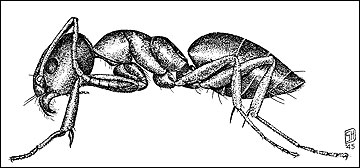 Figure 3
Figure 3
The odorous house ant is about 2 to 3 mm long and dark brown to black in color.
The odorous house ant (Figure 3) is the most common home-infesting ant species in Missouri. It is 2 to 3 mm long and dark brown to black in color. Its most identifiable feature is that it gives off a fruity-coconut smell when crushed between the fingers. Odorous house ants have multiple queens and nest in void spaces both indoors and outdoors. They feed on honeydew and plant nectar outdoors, but when these foods wash away during periods of rain, they invade homes in large numbers to find food. They also scavenge for other kinds of foods. They are attracted primarily to sweet foods indoors during rainy periods during spring and fall.
The odorous house ant establishes colonies with newly mated queens or by budding from existing colonies. Nests in the soil are shallow and often located beneath some object like a board or stone. They especially like stacks of materials as nesting sites. They also nest under loose bark on trees or siding on homes. Most colonies that infest homes are located outdoors. Indoor nests are often associated with moisture within wall voids near pipes, heaters, bathtraps, toilets, etc. They are best managed using sweet baits.
Pharaoh ant (Monomorium pharaonis)
 Figure 4
Figure 4
Pharaoh ants are light tan and measure about 1 to 2 mm long.
Pharaoh ants (Figure 4) are common structural pests. They are only about 1 to 2 mm long and are light tan in color. Their small size and color are their most identifiable features. Pharaoh ants have large colonies with multiple queens that nest in void spaces indoors. No swarming occurs in this species, and almost any tiny space is suitable for a queen to establish following budding. They are common in wall voids, behind baseboards, in electrical outlets and other small void spaces. They feed on all kinds of foods including fats, proteins and sweets that they obtain by scavenging both inside and outside.
The pharaoh ant is particularly difficult to control. It is found nesting in homes and institutional buildings such as hospital and schools. They are often located near moisture. They have been reported feeding on human wounds in hospitals and care centers. Conventional spraying of worker trails causes a single colony to split into several colonies that relocate to new void spaces. This magnifies the problem rather than eliminating it. Baiting is the only effective way of managing pharaoh ant colonies.
Acrobat ant (Crematogaster spp.)
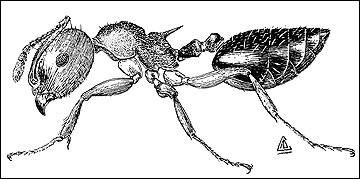 Figure 5
Figure 5
Acrobat ants vary in color from light brown to reddish brown to black and are 2-1/2 to 3 mm long. They have a heart-shaped abdomens that come to a point at the tip.
Acrobat ants (Figure 5) are occasional structural pests. This group of ants varies in color from light brown to reddish brown to black and ranges in size from 2-1/2 to 3 mm long. Their most identifiable feature is a heart-shaped abdomen that comes to a point at the tip. They have a single queen in the colony and nest in wood. Many species build carton sheds to cover certain homopterous insects, then they feed on the honeydew these insects produce. Indoors they are attracted to both sweet and greasy foods.
Acrobat ants establish colonies in dead wood in a variety of locations, including partially decayed logs, stumps, dead branches of trees or woodwork in homes. The ants commonly infest door and window frames previously damaged by moisture. They also like to infest foam panel insulation. They are best managed by injecting liquid insecticide into their wooden nest galleries.
Pavement ant (Tetramorium caespitum)
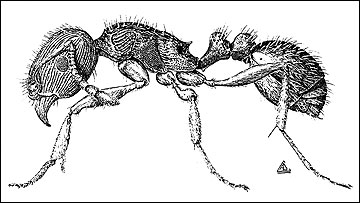 Figure 6
Figure 6
The pavement ant is dark brown to black with light antennae and legs that range from 2-1/2 to 3 mm in length.
The pavement ant (Figure 6) is a dark brown to black ant with light antennae and legs that range from 2-1/2 to 3 mm in length. Their most identifiable feature is the parallel furrows and ridges on the head and thorax. They have a single queen and they nest in soil in the open or under stones and pavement. Their name comes from the habit of nesting beside and under sidewalks, driveways and foundations. They tend subterranean insects that feed on roots for their honeydew.
Most infestations consist of alates (winged ants) emerging indoors. They emerge in the spring from under baseboards, expansion joints, heat registers or from false ceilings. This may continue for weeks. You can removed alates by handpicking, vacuuming or using a fly swatter. Eliminate colonies by locating the outdoor soil nest and drenching it with insecticide.
Larger yellow ant (Acanthomyops interjectus)
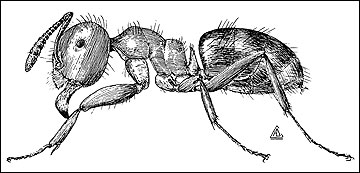 Figure 7
Figure 7
The larger yellow ant is reddish-yellow and ranges in size from 4 to 4-1/2 mm in length.
The larger yellow ant (Figure 7) is reddish-yellow and ranges in size from 4 to 4-1/2 mm in length. One identifiable feature of this ant is the distinct lemon-like odor that workers emit when alarmed or crushed. This odor has prompted other names for this ant, such as the citronella or perfumed yellow ant. The colonies have a single queen. The ants prefer to nest in soil along the foundation of structures. Larger yellow ants feed almost exclusively on honeydew produced by subterranean insects feeding on roots.
This ant becomes a nuisance when alates swarm indoors or when workers dump soil from cracks in the floor or basement wall. Many often mistake them for termites in these situations. Colonies are best managed by drenching their soil nests outdoors next to the foundation.
Field ants (Formica spp.)
This is a large group of ants with many species. Their size varies by species, but most are medium to large ants that range from 4 to 8 mm in length. Their body color also varies by species. Colonies contain a single queen and most species prefer nesting in soil in open areas. Some species incorporate small twigs, grass stems, leaves or pine needles into their nests. These ants are rarely found indoors but are common outside in human environments.
Field ant mounds can reach a foot in diameter and are generally considered to be a blemish to lawns. Some species in Missouri build mounds that are similar in size to red imported fire ant mounds, causing fire ant scares when fire ants are not currently established here. One of these is the Allegheny mound ant (Formica exsectoides) whose mounds can measure 2 meters (6 feet) wide and 1 meter (3 feet) high. Field ant colonies are best managed by drenching their soil nests with a liquid insecticide.
Carpenter ants (Camponotus spp.)
Because they differ considerably from most house-infesting species in their biology and control, carpenter ants have their own guide: MU Extension Publication G7423, Carpenter Ants.